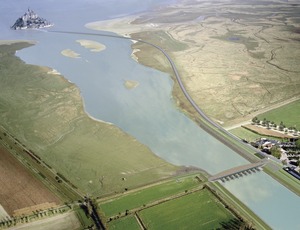

Perched on a rock off France's northern coast and resembling a castle out of a fairy tale, the Benedictine abbey of Mont Saint-Michel is receiving modern-day engineering reinforcements against encroaching salt marshes. The $270-million project, including a new river dam and an unobtrusive steelwork bridge to replace a nineteenth-century causeway, aims to mitigate environmental harm rendered by decades of siltation.
Located on a UNESCO World Heritage site, the Gothic-style abbey was built between the 11th and 16th centuries about 40 kilometers east of Saint-Malo. Aside from Paris, Mont Saint-Michel is France's biggest tourist attraction, pulling in about 2.5 million visitors a year, according to Syndicat Mixte Baie du Mont-Saint-Michel (SMBMS), the consortium of local authorities handling the project.
The abbey's location has been compromised by silt flowing toward the island from the nearby estuary of the Couesnon River. The natural flushing of sea currents was impaired by the 2-km-long earth-embankment causeway, completed in 1879 to provide year-round road access.
Without countermeasures, Mont Saint-Michel would cease to be an island by midcentury, according to SMBMS. The aim of the operation is to restore the marine landscape for 1,000 meters around the island, says a spokeswoman.
A new 85-m-long dam on the Couesnon River is the first major element of the project. Completed at a cost of some $16 million in 2009, the dam includes eight 9-m-wide vertical sector gates. The dam is designed to release the built-up water at the riverbed level to flush the silt out to sea, the spokeswoman adds. With the dam in place, siltation already is being reduced, and the estuary will be restored by 2020, according to a forecast by SMBMS.
Now, the most visible component of $46 million in work is the new bridge being built by Eiffage Construction Métallique S.A., Colombes, under a roughly $17-million contract. Designed by Paris-based Dietmar Feichtinger Architectes with German structural engineering firm Schlaich, Bergermann & Partner, Stuttgart, the 756-m-long bridge contains over 2,000 tonnes of steelwork. It is supported at 12-m intervals by pairs of slender steel-tube columns rising from bored piles. The 11-m-wide deck includes a concrete roadway for shuttle buses and a timber-topped cantilevering footpath. At its shore end, the bridge will run onto a new 50,000-cu-m earth causeway to form the 1.8-km-long new access to the abbey.
The roadway consists of precast concrete slabs acting compositely with a steelwork grid of longitudinal box girders and I-section cross beams. Pedestrians will use a 4.5-m-wide timber-topped walkway, cantilevering to one side.
To reduce the deck's depth, the framework's integrity is maximized by stiffening the whole superstructure, says Andreas Keil, Schlaich, Bergermann's project director. The 144 steel-column bottoms are embedded into the pile tops for additional rigidity. Crews assembled the steelwork in five 120-m-long and two 78-m-long rigid, ladder-like frameworks separated by movement joints. Eliminating bearings will cut down on maintenance, adds Keil.
Today, only a few meters of each supporting column are visible at low tides. But as silt disperses over the years, the seabed level is forecast to drop by about 2.5 m, says Keil. In anticipation, the pile caps are set at more than 4 m below the current sea level. Eiffage installed the first section of bridge last June. The contractor plans to complete steelwork next summer. Then, in 2015, the old causeway will be removed and the project completed.




